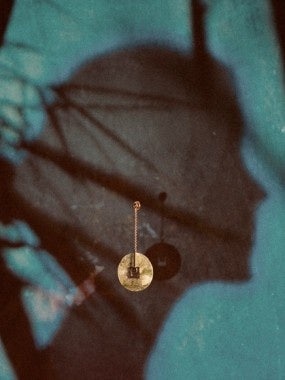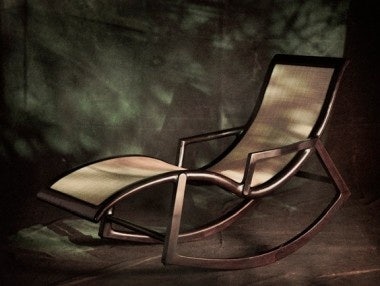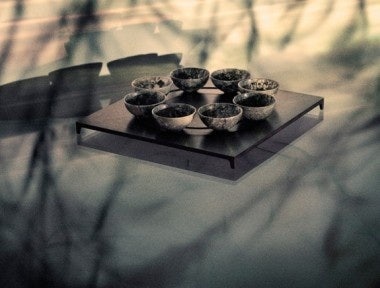"100 Years Ago, China Had Its Own Luxury Brands...Then We Stopped"#

Part two of Jing Daily's exclusive interview with Jiang Qiong'er, artistic director and CEO of Shang Xia, (上下), the Shanghai-based, "made in China" high-end brand cultivated by the French luxury house Hermès. In the first half of our interview, we covered Shang Xia’s first anniversary, the burgeoning appreciation for Chinese design now spreading among more sophisticated urban Chinese, and her plans for brand expansion. Today, we wrap up by discussing the differences between Shanghainese and inland consumers, the development of new Shang Xia collections, and Jiang Qiong'er's plans for the year ahead.
Jing Daily (JD): I’m curious about your thoughts on the luxury business in general here. It’s a very fast-growing market, the fastest-growing in the world, but what’s popular in Shanghai is different from what’s popular in Beijing or Chengdu. Are people here more receptive to design like this compared to someone from another city?#
Jiang Qiong'er (JQE)#
: It’s interesting that we only have one space here but we get many visitors from Beijing, Hangzhou, Chengdu, Chongqing, Qingdao, even Dalian and Hong Kong. From everywhere. And I think the market for Western luxury brands differs if we’re talking about different areas of China, but since Shang Xia is inspired by Chinese culture, there’s something shared among Chinese people. So finally, which is a very interesting point, you don’t see a huge difference where Beijingers just love the furniture, or people from Dalian just love the textiles, it’s quite balanced. You don’t see this huge cultural difference between north and south.
I think maybe it’s because we’re based on Chinese culture -- they all love jade or zitan, or they all drink tea. But if you look at the market, you have few quality options in this field. You have replicas of Ming Dynasty furniture, with zitan wood, greatly done, or antiques. But you don’t have traditional know-how, great quality, and contemporary design. So we are quite unique in this market. People from all over China, even from Hong Kong or Taiwan, share a lot in common in terms of appreciation of our collection in general.
JD: How often do you add new collections?#
JQE#
: We have one collection every year, so next week we will debut the new collection. But each collection features a new topic. Apart from the debut of the new collections in September, we have three smaller waves of arrivals, in March, June and December. We don’t fit in the Fashion Week rhythm, and we don’t do fashion shows, because we’re not a fashion brand. We’re trying to create designs and collections that are timeless. Because the Ming dynasty furniture, the Northern Song dynasty porcelain, the Han dynasty dresses, we feel that these three dynasties are examples of timeless classic beauty. We want to re-translate this for today’s world.

JD: Do you lead the development of new collections or does your team? How does it work?#
JQE#
: I choose the topic, the theme, and then I work with a design team. I develop the collection plan, though, and I’m already thinking about 2013. I think two years in advance. Then, when the team is busy doing the actual collections, I’m already two years ahead in terms of topic. I’ve already settled on the topic of 2013.
JD: I’m sure you’re not going to tell me. (laughs)#
JQE#
: No. (laughs) I have to think far in advance, in terms of the collection plan. Because, like with the tea set we developed for our first collection, we have a long waiting list. It’s one of our best sellers, because it’s all hand woven, with bamboo. And it’s not just decorative, it’s functional. The white porcelain is fired at 1,380 degrees to make the porcelain look like white jade. Even Japanese masters fire their porcelain at 1,300 degrees, as every 10 degrees upward from that is a challenge. We have a long waiting list, because one teapot takes 10 days to make and even a small cup takes about two days. A full set takes one month to three months to produce.
JD: And it’s just one person who makes that? Or it’s a team?#
JQE#
: One person weaves the bamboo, from start to finish. In all, we only have five or six artisans working on that. So customers have to wait to get the set, but they prefer to wait. They insist on waiting. So that’s why this type of collection won’t take off.
JD: In terms of collections, do you try to keep a balanced number of items in each category, like furniture, jewelry, clothing, or do you sometimes want to do more of one type?#
JQE#
: For our new collection, I only added two pieces of furniture, because we have a basic line of eight pieces, and I added two very special pieces. One of them is the “Da Tian Di” tea ceremony table. We made that because there’s nothing like it on the market for people to drink gong fu tea elegantly. You’ll go to a friend’s house, and even if they’re really wealthy, on their beautiful table they have to sit a little wooden tea set with an electric tea kettle, with the cable hanging down, and a plastic hot water bottle. And it’s just not elegant, even though you’re drinking some of the best tea in the world. So what we designed is a beautiful tea ceremony drinking system that’s modular. When you’re using it, it unfolds, and when you’re not, it all folds back in. It’s got an ink stone from Anhui on which you prepare your tea. And we prepared an integrated heater for the tea kettle, plus the cable is hidden. You don’t even see it. So when you’re not using it, it’s still a beautiful table.
Another piece I added to the new collection is a rocking chair. It takes one year to produce one piece, and it’s made of zitan wood. The magic of this piece is that when you’re lying on it, it will only stop rocking if your heart stops. It’s very sensitive. Today, you need to slow down a bit, take your time to think, to rest, so this design is meant to help with that. But we use traditional know-how, without any nails or joints.

JD: I know that different things in your collection are made in different places. Where are your furniture collections made?#
JQE#
: Several places: Zhejiang province, Fujian province. Because different areas have different kinds of wood. We use bamboo from Sichuan, from Jiangxi province, Jiangsu, everywhere. We get some raw materials from Tibet, and we’ve been working with people in Guizhou to get materials, but we’re taking our time with that because most of the products there have a minority, ethnic style, which we aren’t looking for. We want to re-translate their know-how in a contemporary way.
JD: I know some brands try to do designs that are inspired by Chinese minority groups. I’m wondering if people are interested in that here, or if they tend to prefer things that are more readily understandable.#
JQE#
: Yes, because if you use these kinds of Chinese elements, you can get to the market in a shorter time, but then it’s just a fashion trend. Then people get bored with it after a year or two and move on. We try to make new translations and interpretations of culture that are more timeless. It takes us a lot longer than others. For another brand, maybe they’d complete the Guizhou cooperation in a year, but for us, we’re two years in and we still don’t think it’s ready.
JD: It seems like it’s difficult to convince people in China to slow down, because with business and competition here it’s always about speeding up. And I think you’re one of the few people who’s telling people to relax a little. How long do you think it’ll take people to listen to that?#
JQE#
: Different people will take a different amount of time. Some very successful people only realize they need to slow down and enjoy their lives when they get sick. I think sometimes people need to wake up to it when something [bad] happens. Otherwise, just as a general social attitude, it’ll take several generations.
JD: Since you spent a great deal in time in France and have been close to the luxury market for years, what are some of your thoughts on people’s relationship towards luxury goods here?#
JQE#
: I think 100 years ago, China had its own luxury brands: tailors, medicine, tea, jewelry, shoes, jade, famous artisans. Then we stopped, until probably the early 90s. Then the Western luxury brands came about 20 years ago. At that time, for the first 5-10 years it was very fresh and new. So the attitude was all about putting Chinese things aside. That’s the first period.
Then, about 10 years later, some people developed a more reasonable way of thinking. They didn’t put all Chinese things aside. They weren’t just buying based on name and price, they started to look at brand story and history, quality. Over the past three to five years, some of these customers have realized a need from their own cultural backgrounds. They started to wonder, for example, what kind of tea the emperors used to drink. I have a friend who’s a great real estate developer. Once he said he found an artisan who restored a Qing emperor’s furniture at the Forbidden City, and hired this man to create all of the furniture in his office from Qing Dynasty-era wood. He was really proud of it.
So some Chinese people, after 20 or 30 years of being obsessed with Western brands, are starting to look inward. Which doesn’t mean they’ll quit the Western brands altogether. You can have both in your life. You can mix and match. It’s not a competition; it’s just a way of putting cultures together to suit your lifestyle.

JD: It seems like things progress first in Shanghai and Beijing, so maybe the people who encountered the Western luxury brands first are starting to move on while people in the interior of the country are often just getting to that first stage.#
JQE#
: It’s interesting. We find that a lot of people from places like Chengdu know Shang Xia. They fly in from Chengdu, and they bring purchases from here back home. They love Shang Xia.
JD: Do you think some people in second- and third-tier cities like the cultural items a bit more?#
JQE#
: Yes, they’re different from Shanghainese. They have less Western influence. So they’re already more rooted in Chinese soil. Their mentality is different from, like you said, Beijing or Shanghai. They’re not “brainwashed” yet.
JD: Can you say something about your new collection, which is coming out this month?#
JQE#
: The collection is called “Human and Nature,” so starting this September I’m using a lot of natural materials like agate, bamboo, and zitan. The carved agate we’re using has ancient plants pressed into it, which means it’s more than 50,000 years old. It has to be carved from one piece of stone. We’ve also got the zitan rocking chair. Also, we’ve got our own mahjong set. When we told our friends we were doing it, we immediately sold out. Because Louis Vuitton, Gucci, Dunhill, all of these brands did mahjong sets, but they just decorated the outer box with their logos. Inside, it was just plastic. On ours, we didn’t stick the Shang Xia logo anywhere on the box, but each tile inside was individually designed in-house. On top of each tile is metal, and on the rear is sandalwood, so after you play mahjong for several hours, your hands smell like sandalwood. We even cast the coins you use to play in gold, silver and bronze. This is an object we’re really proud of.
On this year’s catalog, we worked again with Paolo Roversi, and instead of using models, we invited our friends to “model” our new collection.
JD: What are you doing differently this year in terms of clothing collections?#
JQE#
: We’re using special pleated cashmere from Nepal and Tibet, so one dress takes about three months of hand-weaving to produce. We’re also doing new collections of jewelry made of white jade, gold and zitan wood.
JD: To wrap up, you’ve been in business for one year. What would you say you’re most proud of from the last year, and what are you looking forward to the most in the year ahead?#
JQE#
: I think what I’m most proud of from the last year is the pride we see from Chinese people who come by the store, and the appreciation we see from people from overseas. This is what’s made us proudest. And for the year ahead, I think we’re most excited about our new collections. The objects themselves are always the most important. And if we have the opportunity to open in Paris, it will be very exciting, but we don’t know exactly where and when. No matter what, it will be very exciting if we do it.